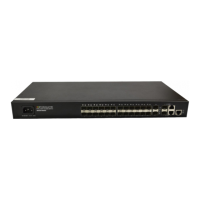VLAN Configuration
Chapter 9. VLAN Configuration
9.1 VLAN Overview
Virtual Local Area Network (VLAN) groups the devices of a LAN logically but not physically
into segments to implement the virtual workgroups. IEEE issued the IEEE 802.1Q in 1999,
which was intended to standardize VLAN implementation solutions.
Through VLAN technology, network managers can logically divide the physical LAN into
different broadcast domains. Every VLAN contains a group of workstations with the same
demands. The workstations of a VLAN do not have to belong to the same physical LAN
segment.
With VLAN technology, the broadcast and unicast traffic within a VLAN will not be
forwarded to other VLANs, therefore, it is very helpful in controlling network traffic, saving
device investment, simplifying network management and improving security.
Figure 9-1 Vlan implementation
A VLAN can span across multiple switches, or even routers. This enables hosts in a VLAN
to be dispersed in a looser way. That is, hosts in a VLAN can belong to different physical
network segment.
Compared with the traditional Ethernet, VLAN enjoys the following advantages.
1) Broadcasts are confined to VLANs. This decreases bandwidth utilization and improves
network performance.
2) Network security is improved. VLANs cannot communicate with each other directly.
That is, a host in a VLAN cannot access resources in another VLAN directly, unless routers or
Layer 3 switches are used.
3) Network configuration workload for the host is reduced. VLAN can be used to group

